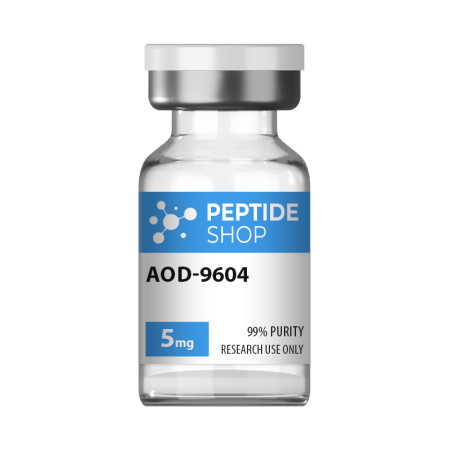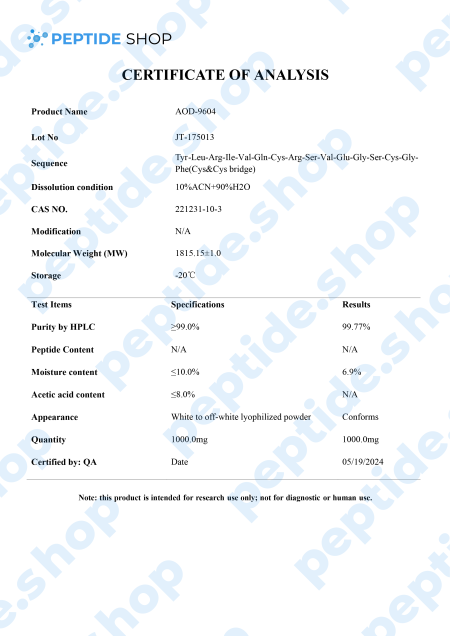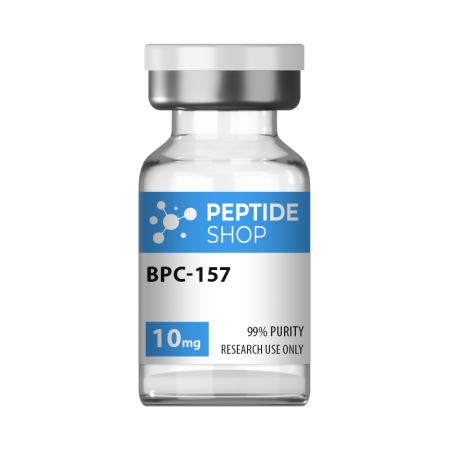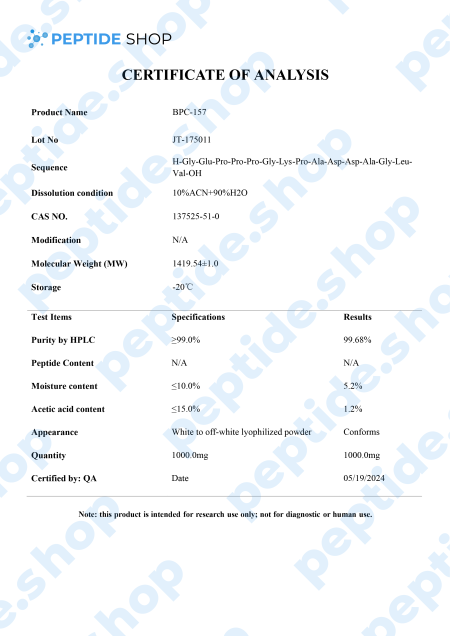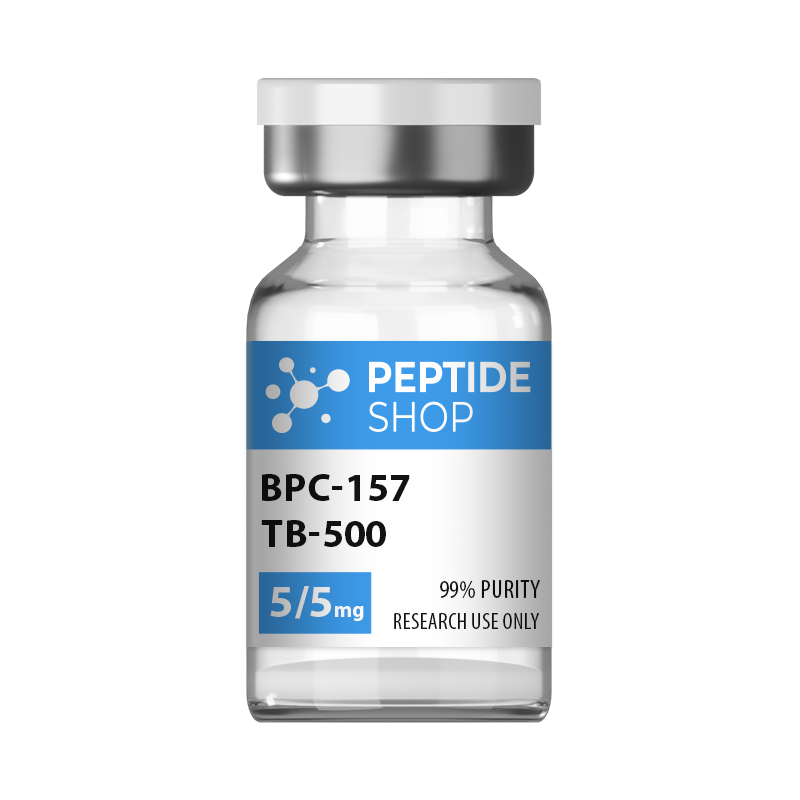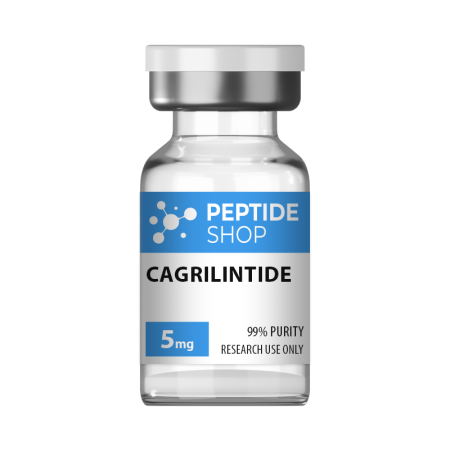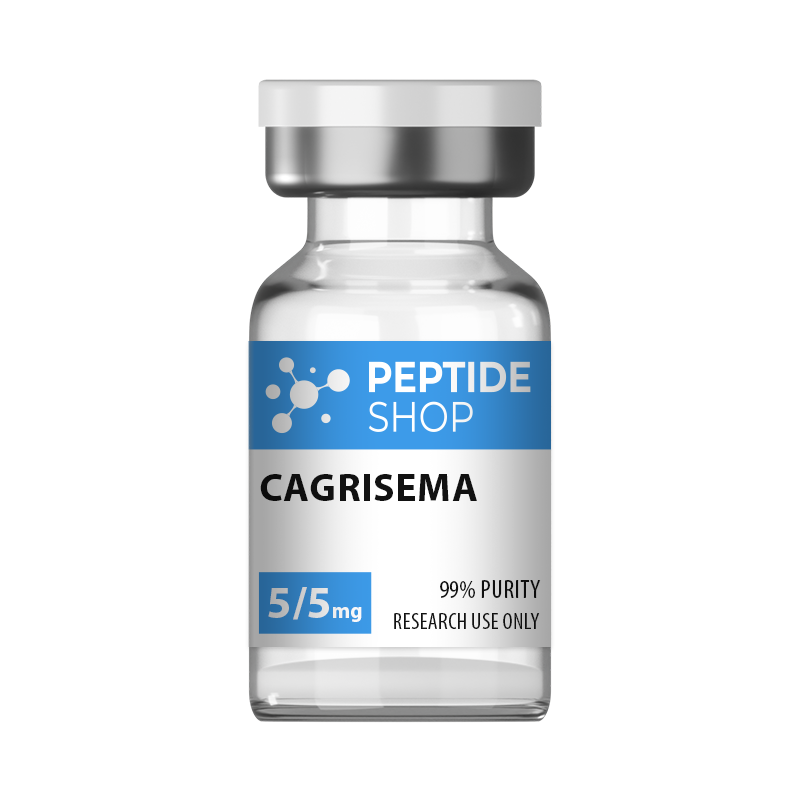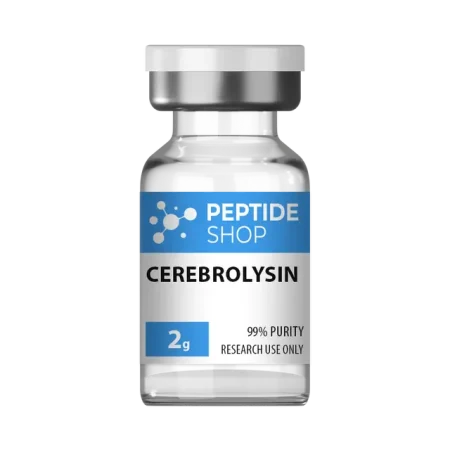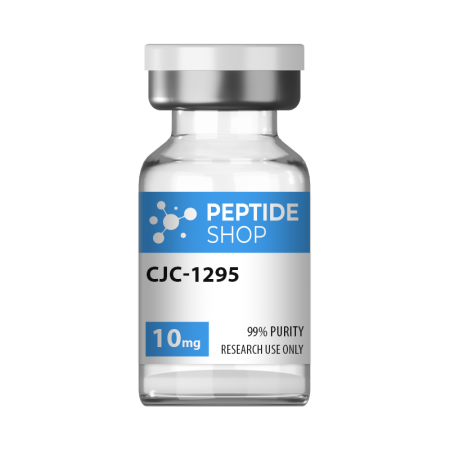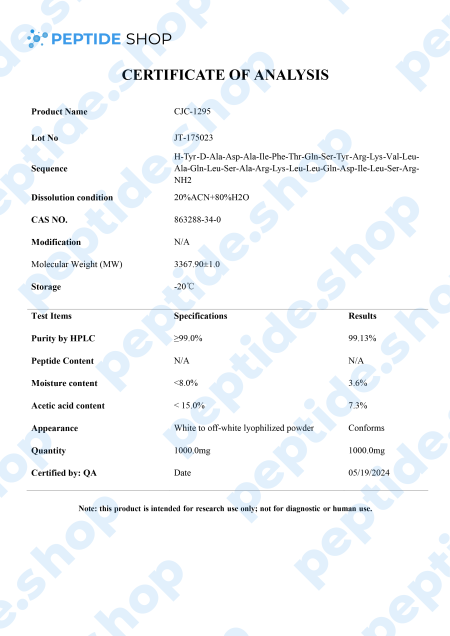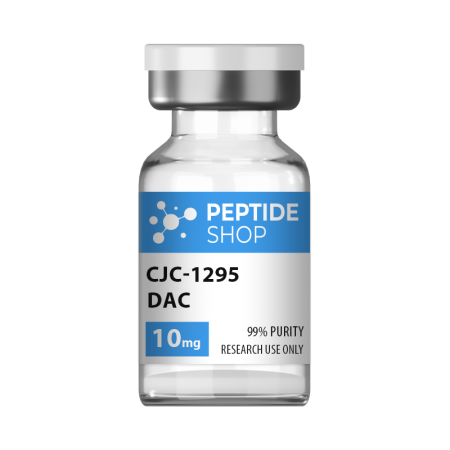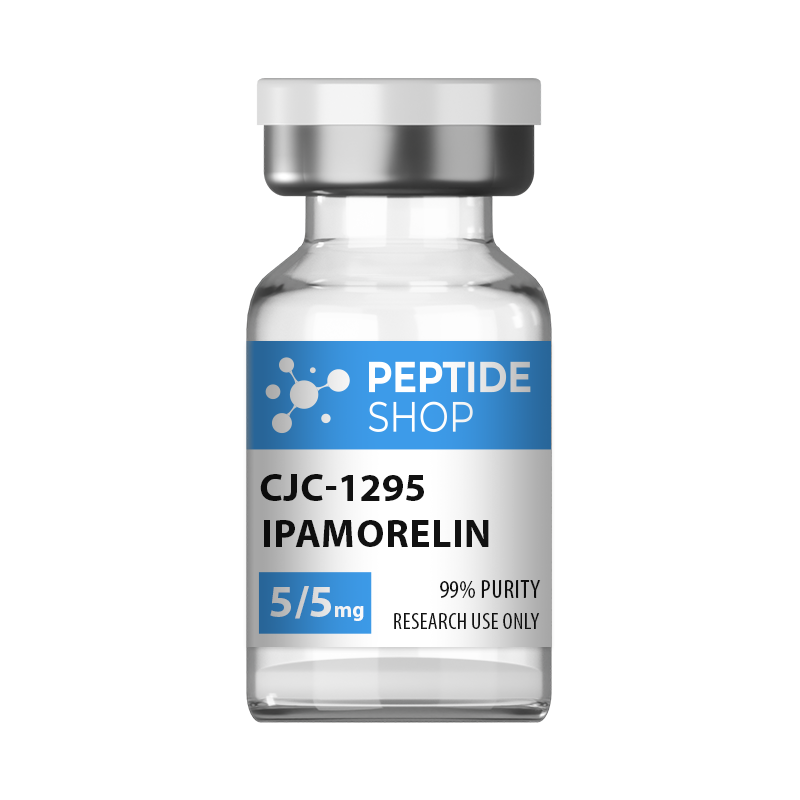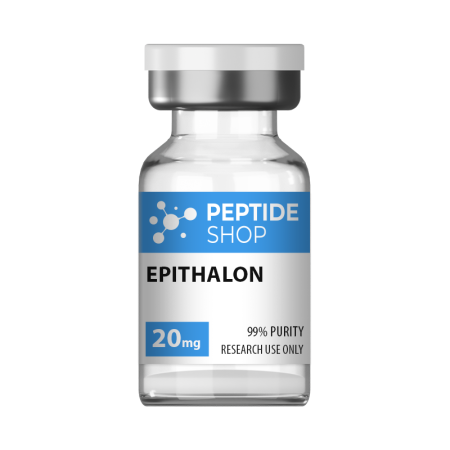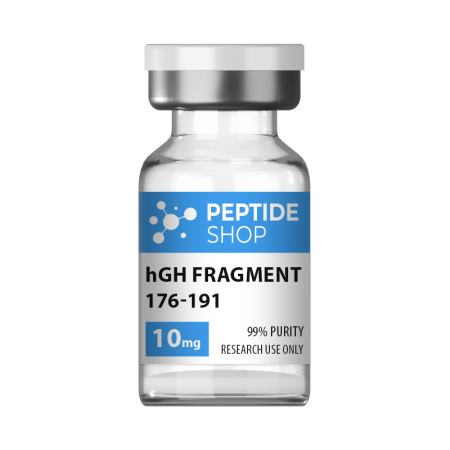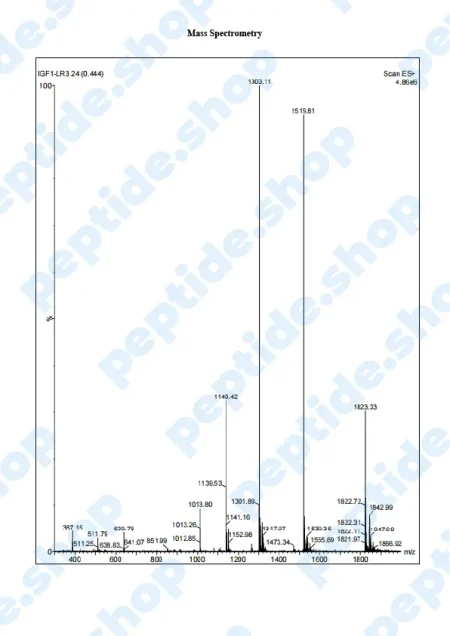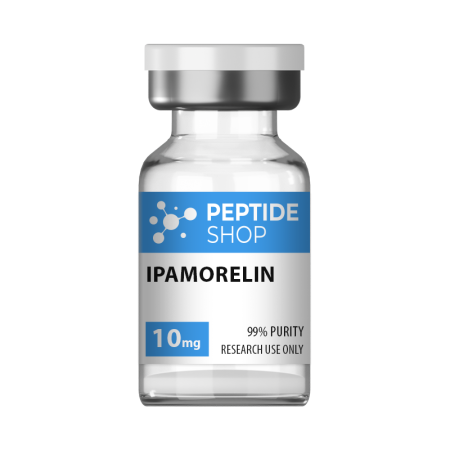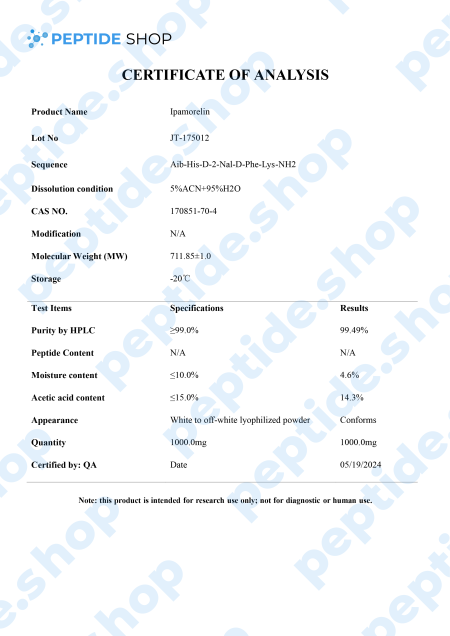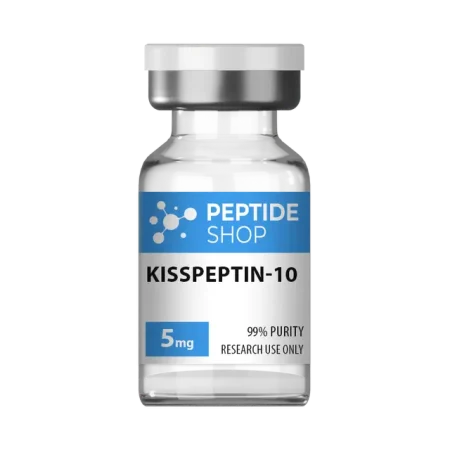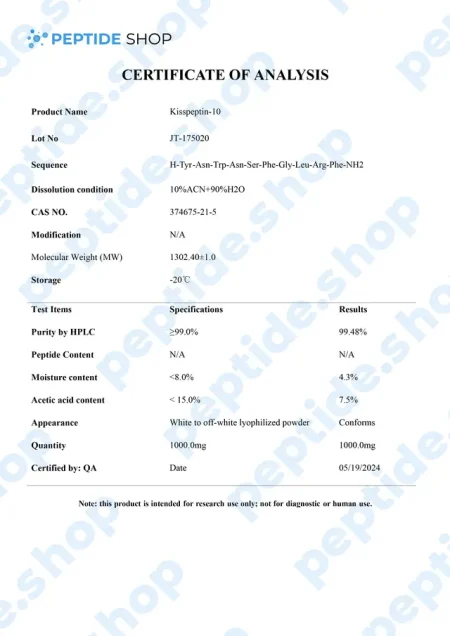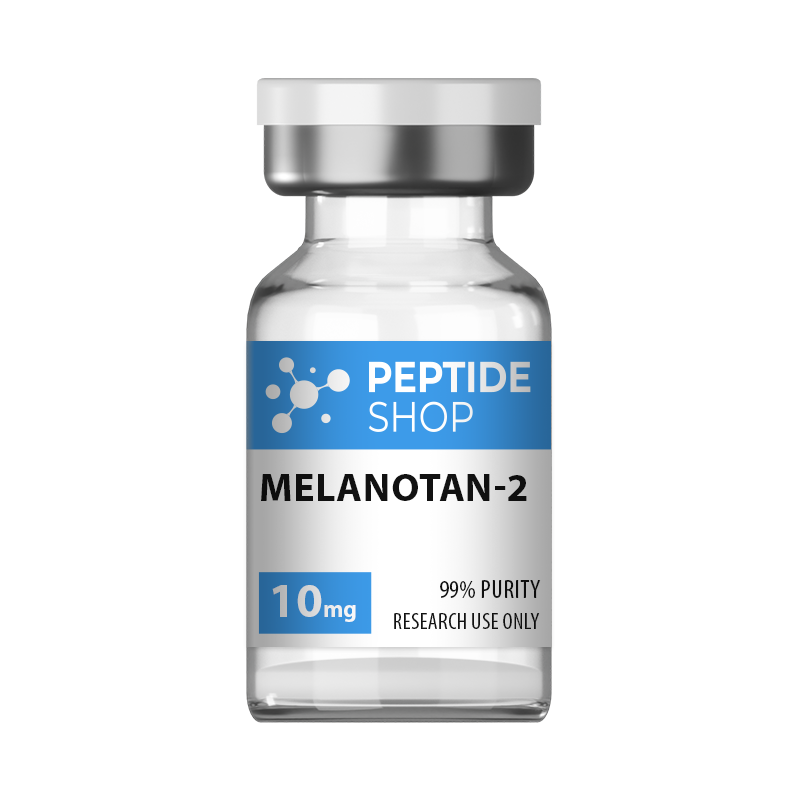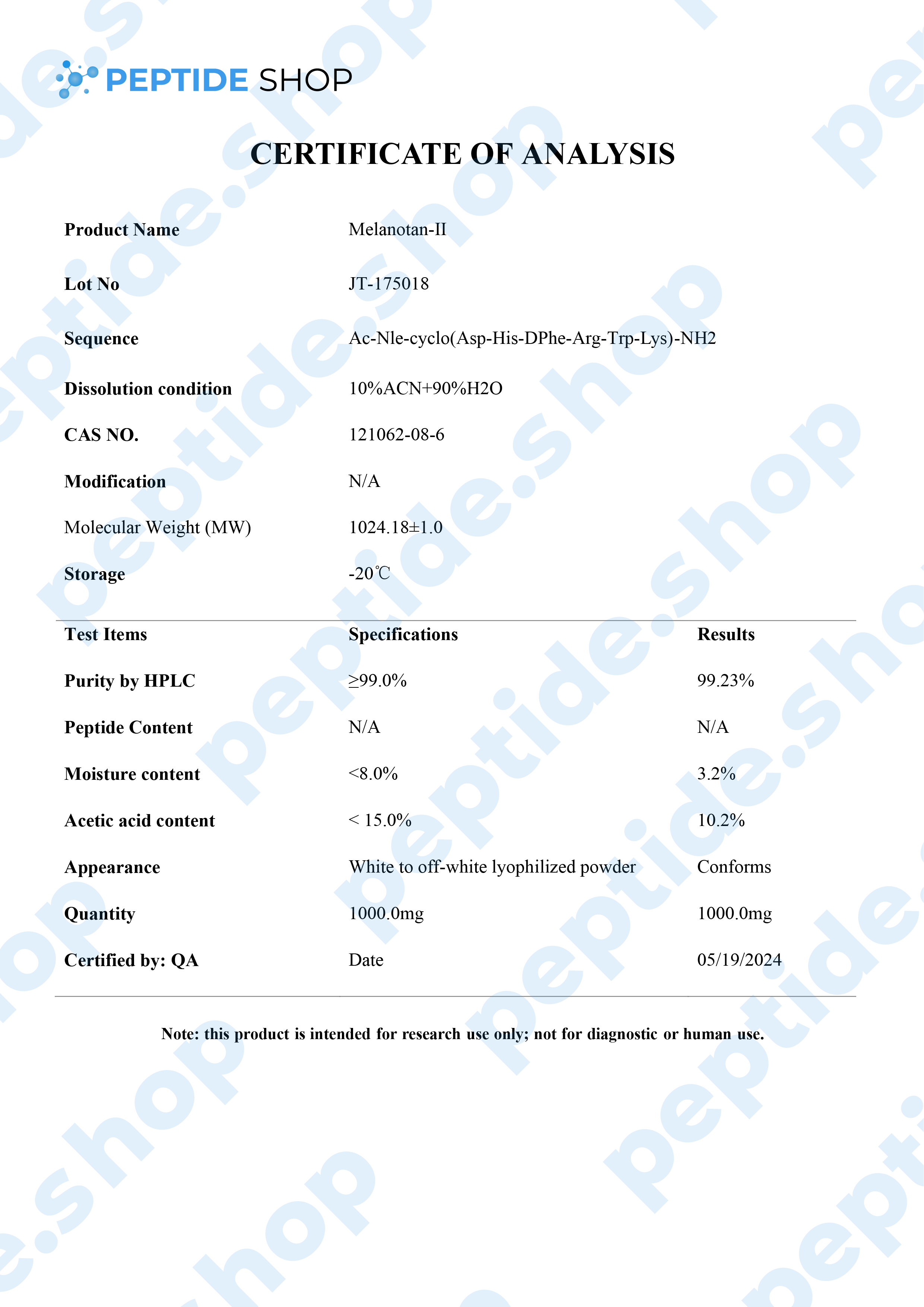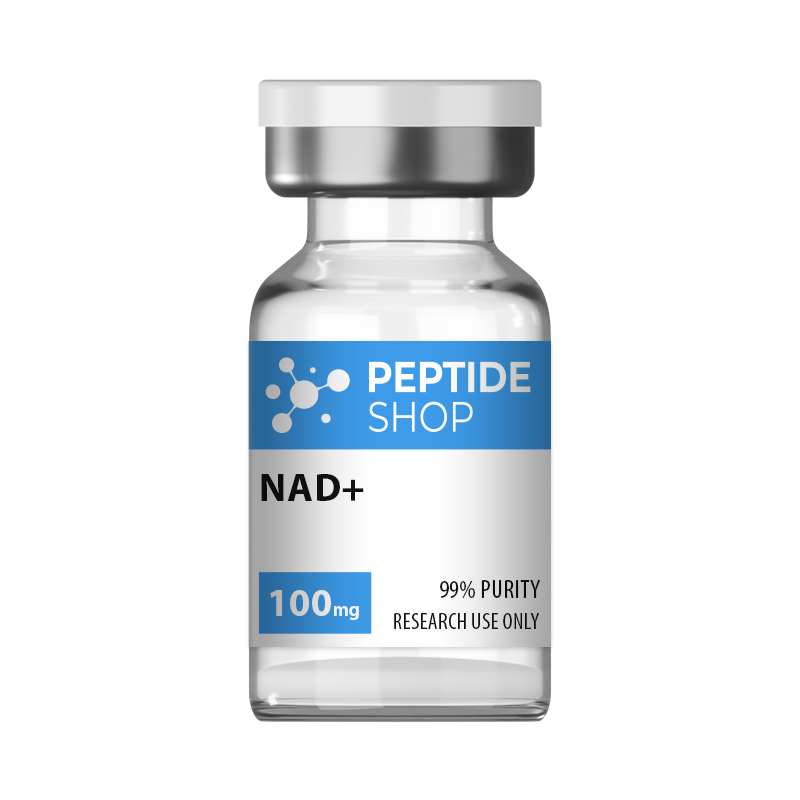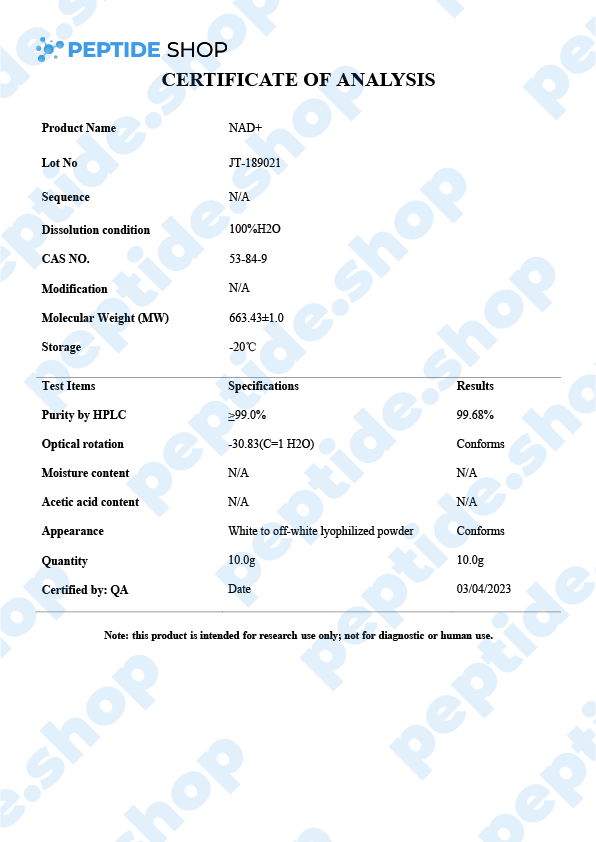Peptide Shop
-
AOD9604 5mg/10mg $50.00 – $90.00
Hunger and satiety signals are controlled by serotonin, dopamine, norepinephrine and a number of other systems within our body. When talking about weight loss and appetite modulation, there are agents that do it through pure central nervous system pathways, and those that target peripheral signals (that travel to the central nervous system).
This is why we have so many different weight loss options, since medication is based on substances affecting different pathways, signals and weight management systems. One such drug, aimed at improving adipose tissue function and fatty acid metabolism is AOD9604.
AOD9604 is a modified form of human growth hormone fragment 176-191, developed to stimulate prolipid mobilizing and lipid oxidation (during which fatty acids decompose into carbonyl compounds, unsaturated aldehydes, ketones and other substances).
Even though AOD9604 has not yet been deemed FDA-approved,a number of studies showed its administration led to a significant weight loss and improvements in glucose tolerance (in both animal and early stage human studies).
Another such study done on 300 obese individuals in Australia showed that AOD9064 administration more than tripled weight loss in test subjects, compared to those on a placebo drug. Furthermore, this study proved that long-term treatment is not likely to cause resistance to AOD9064 based medication, making it a perfect candidate for future weight loss medication and treatment.
So far, animal and human studies both showed AOD9064’s effectiveness in helping test subjects lose weight, improve glucose tolerance, while presenting with minimal side effects. Further research studies are needed before including it into an FDA-approved treatment procedure, but the initial findings show a great potential.
Reference:
Michael D. Jensen. Potential Role of New Therapies in Modifying Cardiovascular Risk in Overweight Patients with Metabolic Risk Factors. 06 September 2012
-
BPC-157 10mg $100.00
BPC-157 is a native gastric pentadecapeptide (composed of 15 amino acids), derivative of body protection compound (BPC). Being a gastric peptide allows for good oral availability and remaining stable for more than 24 hours in human gastric juice. Furthermore, there is no need for a carrier which makes this peptide unique, as compared to others that depend on it.
Clinical studies showed that BPC-157 is highly effective in both treatment and prophylaxis of various gastrointestinal lesions. This effectiveness spans to cover both acute and chronic gastric conditions, intravenous, ingastric, and even as a topical agent for deep skin burns and lesions.
Surprisingly, BPC-157 has also shown a beneficial effect on:
- Brain lesions – in one of the most recent studies researchers concluded that BPC-157 expressed a direct therapeutic effect in rat test subjects following a stroke. This peptide not only delayed neural damage, but also promoted full functional recovery.
- Behavioral disorders – medical research showed that BPC-157 counteracted catalepsy (a state of a trance or a seizure) in rat models. This research indicated a connection between BPC-157 and dopamine as well as glutamate and nitric oxide system (vital in schizophrenia therapy).
- Spinal cord injuries – A particularly interesting study showed that BPC-157 administration to rats with spinal cord injuries resulted in improvements mere 10 minutes after the initial dosage. On the contrary, untreated rats did not fully recover days, weeks, months and, in some rare cases, years following the injury.
In conclusion, we saw BPC-157 application results in a myriad of beneficial effects in various different systems within the body. Of course, many of these studies were performed on animal test subjects and we’re going to need additional ones to clarify its effect in humans and the full extent of its therapeutic potential.
References:
Vukojevic J, Milavić M, Perović D, Ilić S, Čilić AZ, Đuran N, Štrbe S, Zoričić Z, Filipčić I, Brečić P, Seiverth S, Sikirić P. Pentadecapeptide BPC 157 and the central nervous system. Neural Regen Res. 2022 Mar;17(3):482-487. doi: 10.4103/1673-5374.320969. PMID: 34380875; PMCID: PMC8504390.
Sikiric P, Hahm KB, Blagaic AB, Tvrdeic A, Pavlov KH, Petrovic A, Kokot A, Gojkovic S, Krezic I, Drmic D, Rucman R, Seiwerth S. Stable Gastric Pentadecapeptide BPC 157, Robert’s Stomach Cytoprotection/Adaptive Cytoprotection/Organoprotection, and Selye’s Stress Coping Response: Progress, Achievements, and the Future. Gut Liver. 2020 Mar 15;14(2):153-167. doi: 10.5009/gnl18490. PMID: 31158953; PMCID: PMC7096228.
-
BPC-157, TB-500 10mg $120.00
Though we sell BPC-157 and TB-500 individually, we’re also offering this peptide blend to our customers. Both BPC-157 and TB-500 are body protecting compounds naturally occurring in the GI tract, and animal research showed that, when using them in combination, they help repair the GI tract, increase the rate of repair and development of new blood vessels and generally speed up tissue recovery and healing.
Though these peptides act effectively when applied individually, due to the nature of their mechanism of action, they do not compete against each other, but work in conjunction to offer far more superior effects. Of course, these effects have yet to be tested in human test subjects, but animal testing demonstrated high effectiveness in healing and repair.
BPC-157, TB-500 Blend Effects
As previously mentioned, this peptide blend is especially effective in healing and recovery, in animal studies. Here is what the researchers found:
- It helps with injury protection
- Boosts joint flexibility
- Speeds up regenerative processes within the body
- Increases the rate of new blood vessels forming
- Improves gut health and heals intestinal walls
- It may improve physical endurance
- Enhance brain health
- Boost muscle growth and repair damaged bones and joints
Though, individually, both BPC 157 and TB 500 express these effects, this blend supercharges them, allowing for far more powerful end results.
Sadly, we still don’t have many studies showing the effect of this blend in humans, this is why this peptide blend is only available for laboratory research and scientific experiments. But as these experiments continue to progress, we will soon have more information from human test subjects.
Wound and Injury Repair Studies
Studies involving BPC-157 and TB-500, both in combination and individually, clearly showed that these peptides stimulate wound healing and recovery and injury repair. Of course, the majority of these studies were done on animals, and this is where we’re getting our data.
These studies further showed this peptide blend being effective in complete recovery from bone, muscle, joints and connective tissues injuries. Furthermore, BPC-157 and TB-500 blend showed a substantial prophylactic effect, encouraging stronger, more elastic and more durable musculoskeletal structures.
Growth Hormone Effects
This blend’s muscle building and wound healing recovery effect is tied closely to its ability to interact with growth hormone, as shown in animal studies. BPC and TB have a synergistic effect in which BPC 157 accelerates the expression of GH receptors on fibroblasts, which increases the longevity of these cells; while TB 500 increases the rate of wound healing when these GH receptors get activated.
This synergistic effect is what scientists are counting on, to develop a potent wound healing treatment designed to be faster and more effective to those being employed currently. This is why we are eager to see what future development and human studies will show.
BPC-157 and TB-500 Blend Side Effects
When talking about human use, this is the most important question scientists are looking to answer – is this blend safe for human use and does it come with any side effects?
Fortunately for us, individually, these peptides showed safe for use and not dangerous at all; same goes for the blend. But we need to keep in mind that this information comes from animal studies, so until we get some definitive human test subject studies, we won’t know for sure.
Until that happens, PeptideShop.com is only selling BPC-157/TB-500 blend for laboratory research!
-
Cagrilintide $150.00 – $260.00
Obesity’s become a global pandemic, currently affecting one third of the entire population, and this is why we can look at it as a chronic disease that requires appropriate treatment.
When talking about obesity, amylin hormone is of great importance as it gets secreted along with insulin and acts as food intake inhibitor, delaying gastric emptying and suppresses post-prandial glucagon responses to meals.
For this reason, there is a tendency to include amylin management in newly developed medication.
And one such compound is cagrilintide – lipidated long-acting amylin analogue.
Though it still hadn’t been thoroughly tested on humans, numerous rat studies showed incredible potential. One such in vitro study involving rats set out to compare cagrilintide’s effectiveness against pramlintide (an FDA-approved diabetes 1/2 medication).
The study showed that pramlintide reduced food intake by 25% in the period of 0-24 hours (it did not cause reduced food intake after 24 hours). But the dosage was substantial – 1000 nmol/kg.
On the other hand, cagrilintide was able to reduce food intake by approximately 50% with a minimal dosage of only 3 nmol/kg. More importantly, this food intake reduction spanned across 60 hours from the moment it was injected.
These results clearly show the potency of cagrilintide in weight loss and diabetes management medication, especially because it acts over such a long time period (allowing subcutaneous injections to be applied once a week).
Reference:
Dehestani B, Stratford NR, le Roux CW. Amylin as a Future Obesity Treatment. J Obes Metab Syndr. 2021 Dec 30;30(4):320-325. doi: 10.7570/jomes21071. PMID: 34929674; PMCID: PMC8735818.
-
Cagrisema 10mg $165.00
Cagrisema 10mg is one of the latest PeptideShop’s peptide blends, which combines cagrilintide and semaglutide. Each vial contains a combination of lyophilized cagrilintide and semaglutide, 5mg each, tested for purity and strength, and suitable for lab experiments and chemical trials.
Semaglutide is a GLP-1 receptor agonist. GLP-1 is one of the main gut peptide hormones in humans, which plays a role in many different mechanisms within the body from insulin secretion, glucagon release, gastric emptying, appetite and energy intake.
And cagrilintdide is an amylin analogue co-secreted with insulin, which plays a role in glycemic control and gastric emptying.
Researchers hypothesize that this combination profoundly influences receptor changes in the brain, insulin secretion, appetite regulation and glucagon secretion.
Though this combination has not yet been fully tested, we have data from a study on the effects of Cagrisema on patients with type 2 diabetes.This was a 32-week, double-blind study across 17 sites in the USA, conducted on 92 individuals in total.
Final results showed that cagrisema resulted in clinically relevant improvements in glycaemic control (significant change in HbA1c) and, more importantly, a greater weight loss versus semaglutide as well as cagrilintide.
References:
https://www.thelancet.com/journals/lancet/article/PIIS0140-6736(23)01163-7/abstract
-
Cerebrolysin 2mg, 5mg $50.00 – $110.00
Cerebrolysin is a porcine-derived peptide preparation, with a low molecular mass and a variety of research applications. An interesting thing about cerebrolysin is that its preparation contains nerve growth factors, BDFN (brain derived neurotrophic factor), Ciliary nerve growth factor, p-21 and orexin. This means that cerebrolysin contains molecules with:
- Pharmacodynamic properties – it expresses biochemical, physiological and molecular effects within the body.
- Neurotrophic properties – it aids in growing, repair and neuron maintenance
- Neuroprotective properties – it strengthens the neural pathways as well as the neurons themselves and improves synaptic plasticity.
Cerebrolysin Chemical Structure
It’s a bit difficult talking about cerebrolysin as it does not have a single chemical structure, rather, it’s a combination of several different peptides. As such, cerebrolysin is actually labeled an “orphan drug” by the FDA. What this means is it did show promise in disease treatment and prevention (in clinical trials), but only in orphan diseases. Orphan disease is one that affects fewer than 200,000 people in the US. This is why this peptide mix is not a profitable venture for further, independent studies, and research is only possible with financial help from the government.
But in the particular case of cerebrolysin, the government did, in fact, intervene, due to its potential in dealing with dementia and because of its neuroprotective capabilities.
This peptide mix was first developed in Austria, back in 1940 and has since become a vital medicine in Asia, especially Russia and China. Research studies showed that it has the ability to cross the blood-brain barrier and express its pharmacodynamic effects on both brain and the spinal cord.
But, what does it do?
Since cerebrolysin is not a single chemical compound, as we already said, we can look at it, and its effects, through the components its made of:
- Brain-Derived Neurotrophic Factor (BDNF) – this is a protein found in our central nervous system, shown to have a profound effect on neuron growth, synapse growth and health. Research in depression and Alcheimer’s disease revealed disrupted BDNF pattern expression.
- Glial Cell Line-Derived Neurotrophic Factor (GCNF) – this is an exceptionally important, naturally occurring peptide that promotes neuron survival, decreases the loss of neurons and, as some studies have pointed out, has the potential to aid the prevention of Parkinson’s and ALS.
- Ciliary Neurotrophic Factor (CNTF) – this is an interesting hormone affecting the growth of certain neural cells and has been a subject of numerous trials aimed at treating ALS.
- Nerve Growth Factor (NGF) – this is a particularly important peptide which regulates the growth, survival and neuron increase in number. Some studies showed NGF is one of the important factors in programmed cell death and regulation of certain immune system mechanisms.
Looking at these effects, it’s not hard to imagine why scientists used these molecules – to try and merge all these positive effects into one single mix. But were they successful? We actually have some clinical trials atesting to these possibilities:
- Cerebrolysin and Dementia – a study done in 2012 evaluated the outcomes of cerebrolysin therapy in patients with Alcheimer’s over the course of a 12 week treatment period. The study showed significant improvements in cognitive functions and the symptoms of dementia lasting up to several months after the study was finished.
- Cerebrolysin and Parkinson’s – we know that the onset of Parkinson’s disease has to do with the protection of dopamine producing neurons. The loss of these neurons is what leads to motor deficits characteristic for this disease. Unfortunately, we haven’t had human trials, but the one on mice showed that cerebrolysin administration protected these neurons and also lowered certain hormones responsible for Parkinson’s disease worsening.
- Stroke and Brain Injuries – though we don’t have many studies dealing with this topic, some small-scale ones showed cerebrolysin as being not only safe to use, but also helpful in recovery rate if given within 72 hours. Research in infants with brain injury induced communication delay also showed cerebrolysin improved therapeutic outcomes.
Even though these positive effects may seem overwhelming, leaving you wondering why cerebrolysin is not a mainstream, FDA-approved drug still, it’s important to note most of these findings were done on a limited sample (and mostly on animal studies). We have yet to see its effects in large-scale studies and, more importantly, see the long-term benefits of cerebrolysin therapy. Even though the initial results seem promising, we need to be patient and wait for more information before the final verdict.
References:
https://gsrs.ncats.nih.gov/ginas/app/beta/substances/37KZM6S21G%20
Allegri RF, Guekht A. Cerebrolysin improves symptoms and delays progression in patients with Alzheimer’s disease and vascular dementia. Drugs Today (Barc). 2012 Apr;48 Suppl A:25-41. doi: 10.1358/dot.2012.48(Suppl.A).1739721. PMID: 22514793.
Plosker GL, Gauthier S. Cerebrolysin: a review of its use in dementia. Drugs Aging. 2009;26(11):893-915. doi: 10.2165/11203320-000000000-00000. PMID: 19848437.
Masliah E, Armasolo F, Veinbergs I, Mallory M, Samuel W. Cerebrolysin ameliorates performance deficits, and neuronal damage in apolipoprotein E-deficient mice. Pharmacol Biochem Behav. 1999 Feb;62(2):239-45. doi: 10.1016/s0091-3057(98)00144-0. PMID: 9972690.
Ozkizilcik A, Sharma A, Lafuente JV, Muresanu DF, Castellani RJ, Nozari A, Tian ZR, Mössler H, Sharma HS. Nanodelivery of cerebrolysin reduces pathophysiology of Parkinson’s disease. Prog Brain Res. 2019;245:201-246. doi: 10.1016/bs.pbr.2019.03.014. Epub 2019 Apr 2. PMID: 30961868.
Ozkizilcik A, Sharma A, Lafuente JV, Muresanu DF, Castellani RJ, Nozari A, Tian ZR, Mössler H, Sharma HS. Nanodelivery of cerebrolysin reduces pathophysiology of Parkinson’s disease. Prog Brain Res. 2019;245:201-246. doi: 10.1016/bs.pbr.2019.03.014. Epub 2019 Apr 2. PMID: 30961868.
Hassanein SM, Deifalla SM, El-Houssinie M, Mokbel SA. Safety and Efficacy of Cerebrolysin in Infants with Communication Defects due to Severe Perinatal Brain Insult: A Randomized Controlled Clinical Trial. J Clin Neurol. 2016 Jan;12(1):79-84. doi: 10.3988/jcn.2016.12.1.79. Epub 2015 Sep 11. PMID: 26365023; PMCID: PMC4712290.
-
CJC-1295 10mg $90.00
CJC-1295 is a synthetic analogue of growth hormone-releasing hormone (GHRH) and growth hormone secretagogue (GHS) developed by ConjuChem Biotechnologies.
GHRH is a 44-amino acid long peptide which our hypothalamus synthesizes and in the pituitary gland, it binds to the growth hormone (GH) receptors, resulting in the release, regulation and pulsatile secretion of GH.
We already talked about GH therapy as being FDA approved in conditions such as GH deficiency, Turner syndrome, Prader-Willi syndrome, idiopathic short stature etc. Recombinant human GH treatment is generally performed as one daily, subcutaneous injection which elevates the levels of GH serum in the blood.
One of the major problems with this approach to treatment is that the efficacy of GH therapy is hard to determine due to the lack of biological serum biomarkers. Currently, most facilities are using levels of IGF-1 and IGFBP-3 to monitor the efficacy of this therapy but these levels may vary wildly (due to growth velocity, glucose tolerance, insulin levels etc.).
Furthermore, GH abuse extended across multiple sports disciplines, making it even harder to suppress and put this problem under control.
Researchers hope to solve this problem by employing new biomarkers of GH action and secretion. One such way is to employ newly developed molecules, such as CJC-1295, shown to increase both GH and IGF-1 levels in the blood, without affecting the pulsatility of GH secretion. CJC-1295 also has a prolonged half-life of 8 to 10 days, due to its ability to bind to the endogenous serum albumin.
So, what scientists are hoping to achieve with CJC-1295 is both a safe way of promoting GH secretion as well as making it measurable in a laboratory setting. There were numerous studies tackling this issue, but we still need further testing to confirm these preliminary findings.
Reference:
Sackmann-Sala L, Ding J, Frohman LA, Kopchick JJ. Activation of the GH/IGF-1 axis by CJC-1295, a long-acting GHRH analog, results in serum protein profile changes in normal adult subjects. Growth Horm IGF Res. 2009 Dec;19(6):471-7. doi: 10.1016/j.ghir.2009.03.001. Epub 2009 Apr 21. PMID: 19386527; PMCID: PMC2787983.
-
CJC-1295 DAC $110.00
If you’re a peptide researcher (or plan on becoming one), you should know the difference between CJC-1295 and CJC-1295 DAC. CJC-1295 DAC features an additional component at the end of the peptide chain, also known as a drug affinity complex or DAC.
This small fragment changes the peptide’s functionality and extends its half-life to six to eight days. It might have a prolonged effect of up to two weeks.
Below, we will showcase the main similarities and differences between these two peptides, including their properties, characteristics, and mechanism of action.
What is CJC-1295 DAC peptide?
This peptide resembles the regular CJC-1925 since it is a modified form of natural GHGR (1-29). However, this one differs from CJC-1925. It has an additional molecule known as a “drug affinity complex.”
DAC features a couple of oxygen and nitrogen atoms connected by chemical bonds. According to some findings, this small number of atoms could significantly impact peptide breakdown rate and its use in the body.
What is CJC-1295 Peptide?
This peptide is also known as “modified growth hormone releasing factor (1-29)”, “ModGRF 1-29”, or “Modified GRF (1-29).” You may also encounter the name “CJC-1295, without DAC.”
All these names imply a specific peptide molecule containing a short amino acid chain. As many studies have indicated, this peptide may boost growth hormones in the bloodstream.
Growth hormone may have a significant role in several vital internal activities. It could facilitate cellular reproduction, repair, and growth, help with tissue repair, improve muscle cell development, support skin cells, and other functions.
While the body naturally produces growth hormone, this production tends to naturally decrease. According to some research done in laboratory settings, CJC-1295 may encourage the natural production of growth hormone, increasing its levels, which could lead to quicker repair, fat cell burn, and muscle cell growth.
Differences between CJC-1295 DAC and CJC-1295
As research studies have outlined, here are some fundamental differences between these two peptides.
Half-life
The main distinction lies in their half-lives. CJC-1295 is thought to mimic the body’s natural peptide. The endogenous GHRH has a short half-life of just a couple of minutes. Similarly, CJC-1295 has a brief half-life of around half an hour.
Regarding the second peptide, the additional DAC could significantly alter the organism’s peptide use. Researchers believe that DAC offers a peptide, a lysine linker, which could protect and prevent it from degrading.
Moreover, the DAC component could extend the half-life of this peptide to about six to eight days.
Properties of CJC-1295 DAC peptide
It is believed that CJC-1295 DAC boosts growth hormone levels in the bloodstream. Additionally, several studies suggest the following:
- Scientists and researchers need to focus their attention to studying the potential of growth hormones on growth and muscle recovery.
- Growth hormone may help convert fatty tissue into energy.
- Growth hormones are linked with collagen production in the skin, which means this peptide may also help with skin regeneration and skin cell development.
- CJC-1295 DAC may positively impact sleep patterns.
- Growth hormone is essential for tissue regeneration and helps the organism recover from damage.
References:
Teichman SL, Neale A, Lawrence B, Gagnon C, Castaigne JP, Frohman LA. Prolonged stimulation of growth hormone (GH) and insulin-like growth factor I secretion by CJC-1295, a long-acting analog of GH-releasing hormone, in healthy adults. J Clin Endocrinol Metab. 2006 Mar;91(3):799-805. doi: 10.1210/jc.2005-1536. Epub 2005 Dec 13. PMID: 16352683.
Sam L. Teichman, Ann Neale, Betty Lawrence, Catherine Gagnon, Jean-Paul Castaigne, Lawrence A. Frohman, Prolonged Stimulation of Growth Hormone (GH) and Insulin-Like Growth Factor I Secretion by CJC-1295, a Long-Acting Analog of GH-Releasing Hormone, in Healthy Adults, The Journal of Clinical Endocrinology & Metabolism, Volume 91, Issue 3, 1 March 2006, Pages 799–805,
Maria Alba, Danilo Fintini, Alessia Sagazio, Betty Lawrence, Jean-Paul Castaigne, Lawrence A. Frohman, and Roberto Salvatori
American Journal of Physiology-Endocrinology and Metabolism 2006 291:6, E1290-E1294Alba M, Fintini D, Sagazio A, Lawrence B, Castaigne JP, Frohman LA, Salvatori R. Once-daily administration of CJC-1295, a long-acting growth hormone-releasing hormone (GHRH) analog, normalizes growth in the GHRH knockout mouse. Am J Physiol Endocrinol Metab. 2006 Dec;291(6):E1290-4. doi: 10.1152/ajpendo.00201.2006. Epub 2006 Jul 5. PMID: 16822960.Alba, Maria & Fintini, Danilo & Sagazio, Alessia & Lawrence, Betty & Castaigne, Jean-Paul & Frohman, Lawrence & Salvatori, Roberto. (2007). Once-daily administration of CJC-1295, a long-acting growth hormone-releasing hormone (GHRH) analog, normalizes growth in the GHRH knockout mouse. American journal of physiology. Endocrinology and metabolism. 291. E1290-4. 10.1152/ajpendo.00201.2006. -
CJC-1295, Ipamorelin $100.00
CJC-1295 and Ipamorelin peptide are often used in conjunction as their action is synergistic and more than doubly effective. PeptideShop.com offers this blend in a total quantity of 10mg (5mg each).
CJC-1295 Peptide
CJC-1295 is a synthetic hormone-releasing hormone analogue and growth hormone secretagogue. It was developed by ConjuChem Biotechnologies as a means to promote regulation and pulsatile GH secretion. GH therapy is an FDA approved way of treating its deficiencies, diseases such as Turner or Prader-Willi syndrome, idiopathic short stature etc.
The only problem with this approach to treatment is it might be problematic to determine the effectiveness of these therapies due to lacks of biological serum markers. CJC-1295 peptide was developed to mitigate these problems and uncover a more potent and measurable way of secreting GH without affecting its pulsatile nature.
Ipamorelin Peptide
Ipamorelin is also a growth hormone secretagogue, but it also acts as a ghrelin hormone secretagogue receptor agonist, as demonstrated in both in vitro and in vivo studies. Even though its effect is similar to that of CJC-1295, the interesting thing about Ipamorelin is that it does not raise ACTH (Adrenocorticotropic hormone), or cortisol levels for that matter, making it the first GHTP receptor agonist with selective GH release ability.
CJC-1295 And Ipamorelin Peptide Blend
Rather than administering one peptide or the other, more and more research is aimed at testing out the synergistic effect of these two peptides. Some studies showed a 3 or even 5 fold increase in growth hormone secretion increase!
Both CJC-1295 and Ipamorelin will stimulate the pituitary gland to increase GH production and release more hormones through the bloodstream. Animal studies also demonstrated significant ghrelin stimulation, resulting in food intake, fat deposition and muscle building control.
Despite seeing these beneficial results in both GH secretion and appetite regulation, this therapy is still not an FDA approved treatment, as most of our data comes from animal studies. Definitive human studies are needed before moving into the realm of human consumption.
References:
-
Epithalon 20mg/50mg $90.00 – $200.00
Epitalon is a synthetic peptide, made up of 4 amino acids – alanine, glycine, glutamic and aspartic acid. It’s based on a natural peptide epithalamion, commonly extracted from the pineal gland. Some earlier studies showed epitalon’s antioxidant potential, so more recent ones started focusing on its anti-aging potential.
Recent studies also showed its potential in regulating DNA changes, treating infectious diseases… even addressing some types of cancer.
Anti Aging Properties
The fact that epitalon is epithalamin’s extract, means it has the ability to eliminate free radicals that cause tissue damage. A particular research study on flies and mice showed that, after epitalon’s administration, fruit flies mortality rate dropped by a whopping 52%, while the mortality rate in rats dropped by 27%, as compared to the control studies. What researchers learned from this study was that regular epitalon administration stimulated the synthesis and secretion of melatonin, which inhibits free radical production and its subsequent damage.
There was another in vitro study on human somatic non-reproductive cells suggesting that epitalon peptide affects telomerase activity. Telomerase is an enzyme present in cells, allowing them to live longer. So, essentially, this study showed the researchers that this therapy leads to the prolonged cell lifespan. Of course, we still need full scale human studies to see the full extent of prolonged cell lifespan.
DNA Effects
Epitalon also interacts with DNA gene expression, allowing it to have an indirect effect on a whole host of potential bodily functions – from immune system, to skin, tendon and connective tissue repair.
This essentially allows epitalon peptide therapy to have a dual potential effect – on the one hand, it strengthens the immune system and protects the body from outside factors, and on the other, it allows the body to repair and regenerate its structures on its own.
Skin Cell Regeneration
We already talked about epitalon’s effect on DNA and genes. This effect extends to the fibroblast producing and maintaining MMP2. Interestingly, this peptide also affects other skin components, such as collagen and elastin.
Of course, we still have yet to see definitive human studies, but animal ones showed promising results. Young and old rats exposed to epitalon showed skin fibroblast proliferation of 29 and up to 45%. Not only that, epitalon also activates enzymes that slow down programmed cell death.
References:
Yue X, Liu SL, Guo JN, Meng TG, Zhang XR, Li HX, Song CY, Wang ZB, Schatten H, Sun QY, Guo XP. Epitalon protects against post-ovulatory aging-related damage of mouse oocytes in vitro. Aging (Albany NY). 2022 Apr 12;14(7):3191-3202. doi: 10.18632/aging.204007. Epub 2022 Apr 12. PMID: 35413689; PMCID: PMC9037278.
Anisimov VN, Mylnikov SV, Khavinson VK. Pineal peptide preparation epithalamin increases the lifespan of fruit flies, mice and rats. Mech Ageing Dev. 1998 Jun 15;103(2):123-32. doi: 10.1016/s0047-6374(98)00034-7. PMID: 9701766.
Khavinson VKh, Bondarev IE, Butyugov AA. Epithalon peptide induces telomerase activity and telomere elongation in human somatic cells. Bull Exp Biol Med. 2003 Jun;135(6):590-2. doi: 10.1023/a:1025493705728. PMID: 12937682.
-
hGH Fragment 176-191 $80.00
Numerous studies have shown that this peptide may represent numerous opportunities for competent scientists to investigate, especially cartilage regeneration and fatty tissue mitigation.
What is Fragment 176-191 peptide?
This synthetic amino acid sequence mimics the hGH sequence, starting from position 177 to position 191.
AOD 9604, or “lipolytic extract,” is another name for Fragment 176-191. Many researchers argue that Fragment 177-191 may be an important research compound in the context of obesity. They believe it can potentially burn fat in animal models in laboratory settings.
Despite positive results, Fragment 176-191 hasn’t been used for human research purposes and doesn’t have official medical approvals.
Growth hormone
According to research, it appears that hGH Fragment 176-191 may not produce any side effects often related to hGH supplementation. Several adverse effects, such as, impaired glucose tolerance, insulin resistance, and increases in IGF-a levels, have cast doubt on hGH’s use as an obesity treatment. However, when it comes to hGH Fragment 176-191, it doesn’t seem to be impacting blood IGF-1 levels or negatively affecting carbohydrate metabolism.
A trial conducted on Zucker rats in 2000 showed no detrimental effects on insulin sensitivity. Also, an investigation on obese mice done in 2001 did not seem to affect insulin secretion.
Properties
Studies conducted on animals suggest that this peptide can exhibit significant theoretical properties, which will be outlined below:
- The main potential of this Fragment is its lipolytic properties or, in other words, fat-reducing potential. While growth hormones promote development in infancy, they have also been speculated to have an important purpose in maturity.
- Lipoprotein lipase inhibitors may be activated in fat cells,
- By stimulating lipolysis in adipocytes may lead to a decrease in fat cell bulk,
- It might lead to loss of fat from the host body,
Weight
A 14-day trial researching overweight mice came to a conclusion that Fragment 176-191 may have increased skeletal muscle thermogenesis and boosted fat burning.
The study results indicated that this peptide may have enhanced beta (3)-AR RNA (ADRB3) levels, which caused rapid weight reduction in overweight animals but didn’t have much effect on lean mice.
Cartilage
Based on other animal research, it appears that hGH Fragment 176-191 may boost the effects of hyaluronic acid (HA). When Fragment 176-191 was combined with hyaluronic acid, it might boost cartilage formation in white rabbits which have issues with osteoporosis.
References:
Habibullah MM, Mohan S, Syed NK, Makeen HA, Jamal QMS, Alothaid H, Bantun F, Alhazmi A, Hakamy A, Kaabi YA, Samlan G, Lohani M, Thangavel N, Al-Kasim MA. Human Growth Hormone Fragment 176-191 Peptide Enhances the Toxicity of Doxorubicin-Loaded Chitosan Nanoparticles Against MCF-7 Breast Cancer Cells. Drug Des Devel Ther. 2022 Jun 27;16:1963-1974. doi: 10.2147/DDDT.S367586. PMID: 35783198; PMCID: PMC9249349.
https://www.sciencedirect.com/science/article/abs/pii/0304416582900332
Habibullah, Mahmoud & Mohan, Syam & Syed, Nabeel & Makeen, Hafiz & Jamal, Qazi & Alothaid, Hani & Bantun, Farkad & Hakamy, Ali & Kaabi, Yahia & Samlan, Ghalia & Lohani, Mohtashim & Thangavel, Neelaveni & Al-Kasim, Mohamed. (2022). Human Growth Hormone Fragment 176–191 Peptide Enhances the Toxicity of Doxorubicin-Loaded Chitosan Nanoparticles Against MCF-7 Breast Cancer Cells. Drug Design, Development and Therapy. 16. 1963. 10.2147/DDDT.S367586.
-
IGF-1 LR3 $285.00 – $420.00
PeptideShop.com is selling insulin-like growth factor 1 (IGF-1) LR3 in vials of 3mg, in a lyophilized state, and it requires dissolution. Your choice of diluent will depend on the nature of your lab testing, but the most common ones are certainly sterile distilled water, or a sterile dilute acetic acid.
IGF-1 LR3 is based on IGF which has been chemically altered to have a prolonged half-life. This allows it to be more effective and increases the duration of its action.
IGF-1 is a 70 amino acid long peptide chain, similar in structure to insulin, which is able to bind to the insulin receptors found within the body. Insulin-like growth factor 1 is one of the principal mediators of human growth hormone (GH). What this means is IGF-1 plays a crucial role in promoting cell growth, differentiation and has a distinct anabolic effect, especially in adults.
IGF-1 LR3 And Cell Proliferation
Since IGF-1 is a part of a wide growth factor network, it plays a part in cellular proliferation and differentiation, especially in muscles and connective tissue. It also delays cell apoptosis, preventing premature cell death.
The difference between IGF-1 and IGF-1 LR3 variant is, as we said before, LR3’s longer half life; it remains in the bloodstream longer and expresses its action over a longer period.
In vitro medical studies showed that this peptide leads to the increase of muscle cells, not by hypertrophy but by actual cell division. This “side effect” proved of interest in the bodybuilding world where individuals would use (abuse) it to improve their results and get results faster. It came to a point where this peptide was declared a doping agent and banned in different high level sports competitions.
Of course, this is not something we approve of, as we are only selling peptides for laboratory testing.
IGF-1 As A Medical Disease Marker
We’re used to talking about IGF-1 and its LR3 counterpart, in the context of medical therapy and treatment, but its levels might point to a medical problem – deficiency within the body. There are many different reasons for IGF-1 deficiency, but it’s suspected that the main one is GH and growth hormone receptor defects. This is especially common in children where primary IGF deficiency is detected and treated.
IGF-1 LR3’s Effects On Myostatin Regulation
Myostatin is a protein found in muscle tissue of the skeletal system, mainly responsible for hypertrophy and cell division and differentiation. We’re not talking about muscle building here, but normal bodily muscle development during the growth period.
Deficiencies with this hormone will lead to muscle dystrophies, where affected individuals experience muscle loss, decreased quality of life as well as life expectancy. This is why researchers are so hung up on developing a IGF-1 LR3 treatment protocol that would help regulate myostatin protein, prevent muscle loss and improve the quality of life of the patients.
Sadly, we are still in the early stages of testing and research – most commonly used models are animal ones, and we have yet to see the effects of this therapy in humans.
IGF-1 LR3 Effects On Cell Aging
In addition to cell proliferation, differentiation and wound healing, some animal studies showed IGF-1 LR3 affects cellular longevity (by protecting them and prolonging apoptosis).
Besides general wellbeing, this therapy can be aimed at slowing down the progression of deteriorating diseases such as dementia or muscle dystrophy. These results have been reported in mice studies, but we should move into human testing soon.
References:
Bailes J, Soloviev M. Insulin-Like Growth Factor-1 (IGF-1) and Its Monitoring in Medical Diagnostic and in Sports. Biomolecules. 2021 Feb 4;11(2):217. doi: 10.3390/biom11020217. PMID: 33557137; PMCID: PMC7913862.
-
Ipamorelin 10mg $80.00
Ipamorelin is a pentapeptide that showed a significant growth hormone secretion potential both in vitro and in vivo studies. In vivo studies, it showed a similar potency and effectiveness as GHRP-6 (a synthetic growth hormone-releasing hexapeptide) as it stimulates GH release via the GHRP receptors.
What’s interesting about ipamorelin is that it did not raise ACTH (Adrenocorticotropic hormone) nor cortisol level significantly; something we’ve seen happening with GHRP-6 and GHRP-2. So, we can conclude that ipamorelin is the first GHRP-receptor agonist with GH release selectivity similar to GHRH. This is why ipamorelin is an interesting candidate for further testing.
In addition to stimulating GH secretion, this peptide has seen some interesting use in the treatment of postoperative ileus (POI), a condition characterized by transient loss of gastrointestinal motility following abdominal surgery.
The exact mechanism behind POI is a complex one, involving many different bodily structures; in addition, condition is often worsen due to the opioid drugs used for patient pain management.
In rodent studies, ipamorelin was found to selectively stimulate ghrelin (hormone produced by our stomach, affecting food intake, deposition and growth hormone release) without raising cortisol or adrenocorticotropic hormone levels. These effects were shown in both lower GI tract as well as the upper, making this peptide a viable candidate for potential POI treatment.
References:
Raun K, Hansen BS, Johansen NL, Thøgersen H, Madsen K, Ankersen M, Andersen PH. Ipamorelin, the first selective growth hormone secretagogue. Eur J Endocrinol. 1998 Nov;139(5):552-61. doi: 10.1530/eje.0.1390552. PMID: 9849822.
Greenwood-Van Meerveld B, Tyler K, Mohammadi E, Pietra C. Efficacy of ipamorelin, a ghrelin mimetic, on gastric dysmotility in a rodent model of postoperative ileus. J Exp Pharmacol. 2012 Oct 19;4:149-55. doi: 10.2147/JEP.S35396. PMID: 27186127; PMCID: PMC4863553.
-
Kisspeptin 5mg/10mg $60.00 – $110.00
Metastin or Kisspeptin is believed to have the ability to prevent the spread of cancer or metastasis. This peptide is produced by the hypothalamus, which stimulates the release of GnRH or gonadotropin-releasing hormone, which then causes follicle-stimulating hormone and luteinizing hormone to be released from the purity gland.
Kisspeptin is used in testosterone replacement therapy instead of hCG to increase testosterone levels. That’s why it has emerged as a crucial regulator of the mammalian reproductive axis.
This peptide was first discovered in 1996 when it managed to inhibit melanoma cell lines. It belongs to a family of peptides that are derived from the KISS1/kiss1 gene structure, forming from prepro-kisspeptin, which has differential proteolysis for a common precursor.
Kisspeptin is classified as an RF or neuroactive peptide with a specific Arg-Phe-NH2 motif.
Benefits:
Kisspeptin binds to receptors in the pituitary gland, triggering a response that prompts the gland to release neurotransmitters, signaling the release of LH and FSH.
Based on numerous animal studies, scientists have managed to uncover the following benefits:
- Boosts the production of testosterone naturally
- Regulates fertility
- Increases sexual drive
- Improves immune response
- Boosts brain function
- Promotes weight loss
How does Kisspeptin work?
This peptide stimulates the release of GnRH or gonadotropin-releasing hormone. It enters the purity gland through receptor sites, causing a gland to release neurotransmitters, which later signal the releases of FH and LH. These hormones play a crucial role in the production of oestradiol and testosterone.
Kisspeptin mimics the action of hCG and clomiphene, and according to some animal studies, it can affect fertility in female and male animals.
Distribution of Kisspeptin
Kisspeptin was first found in the placenta, and later, it has been observed in the small intestine, pancreas, ovaries, and testis in mammals. The primary expression of Kisspeptin and its receptors have been shown in two big neuronal populations within the hypothalamus of rodents, the anteroventral periventricular nucleus and the arcuate nucleus.
-
Melanotan 2 $55.00
Melanotan 2 is a synthetic version of human alpha-melanocyte stimulating hormone and acts as a non selective melanocortin-receptor agonist. It was mainly developed as a sunless tanning option, but some clinical studies showed it also causes spontaneous penile erections, as well as general sexual stimulation.
Some of the other “side effects” researchers noticed were reduction in compulsive behavior, reduced glucagon production, hunger suppression and even some limited addiction control.
Melanotan 2 Effects On Autism
There is some additional recent clinical research suggesting there might be a link between Mealnotan 2 and autism. Of course, melanotan treatment cannot reverse autism, sadly, but it may act on some aspects of this disorder and make it more manageable.
In mouse model studies researchers recorded that MT2 stimulated oxytocin release, which had the potential to reduce (in some cases counteract) common ASD behaviors – behaviors that include:
- Hand clapping
- Bouncing on toes
- Body rocking
- Holding body parts in unusual positions
- Repeating vocalizations etc.
-
NAD+ $55.00
Nicotinamide adenine dinucleotide (NAD+) is a critical coenzyme that’s present in every living cell and, as such, is involved in a number of metabolic and cellular processes. This is why NAD+ is so interesting for many different areas of research such as:
- Anti aging
- Metabolic disorders
- Neurodegenerative disorders
- And even cancer research
PeptideShop.com sells NAD+ peptide in vials of 100mg and is meant for laboratory use only. Researchers commonly use it to test its effectiveness on:
- DNA damage repair and gene expression
- Stress response regulation
- Slowing down the progression of degenerative disorders
- Metabolism pathway testing
But, as previously mentioned, we are still waiting on large scale human tests.
NAD+ Role In Cellular Maintenance
Cellular NAD exists in two forms:
- NAD+
- NADH
When there’s a shift in NAD+ and its level drops in favor of NADH, this is a hallmark of aging; though the exact mechanisms that lead to this drop still remain unknown.
Naturally, numerous clinical studies showed that increasing NAD+ levels leads to the reduction of age-related immune and metabolic changes. Meaning there is potential of using NAD+ in treating age related disorders.
NAD+ And Neurodegenerative Disorders
When speaking about aging, one of the most contributing factors is mitochondrial dysfunction in neurons. Aging also speeds up the progression of neurodegenerative disorders, triggering DNA damage and mitochondrial impairment.
Luckily, studies have shown that NAD+ treatment (and even supplementation) helped restore mitochondrial function, enhance neural function and even improve cognitive abilities.
NAD+ And Metabolic Disorders
We’ve seen a dramatic increase in metabolic disorders lately, making it one of the major global health problems. Of course, we use the term metabolic disorders to cluster a whole host of problems such as obesity, diabetes, hypertension, as well as some cardiovascular pathologies.
NAD+ levels directly influence nutrient status in cells, so regulating them stands as a clear guideline to future research in hope of making NAD+ an FDA-approved way of treating metabolic and age related disorders.
https://www.ncbi.nlm.nih.gov/pmc/articles/PMC7973386/


 Anti Aging
Anti Aging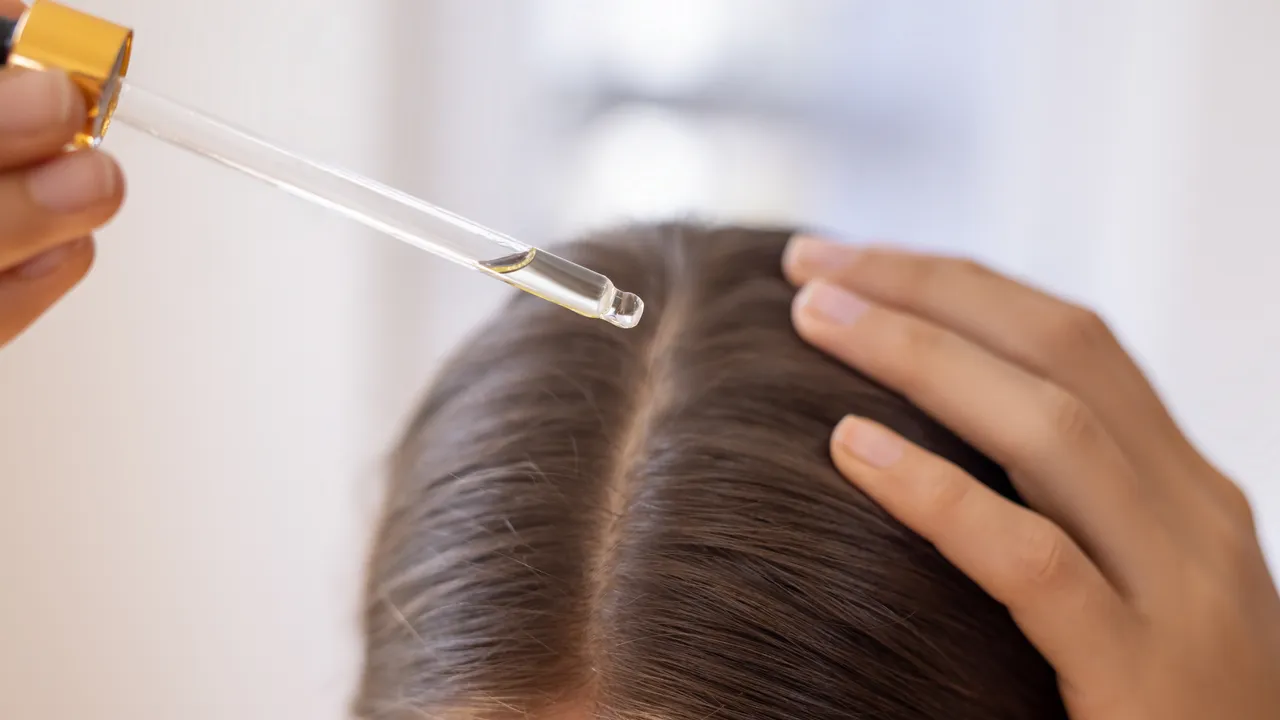 Hair Growth
Hair Growth Muscle Growth
Muscle Growth Peptide Blends
Peptide Blends Peptide Supplies
Peptide Supplies Peptides
Peptides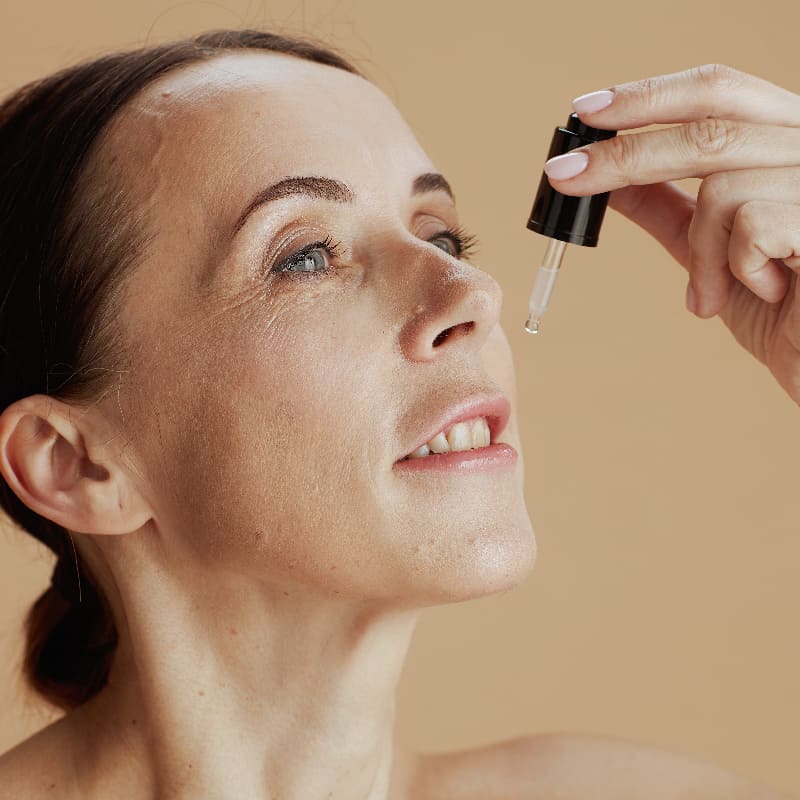 Skin
Skin Testosterone
Testosterone Weight Loss
Weight Loss